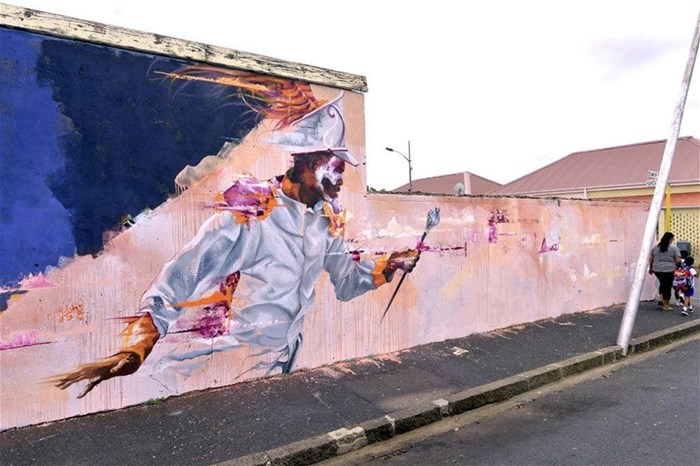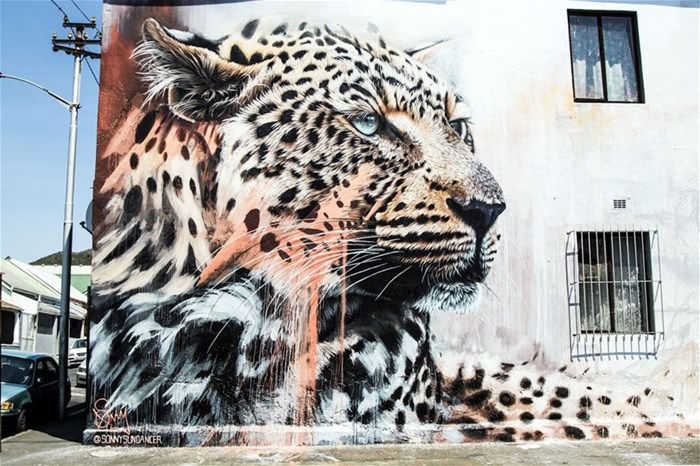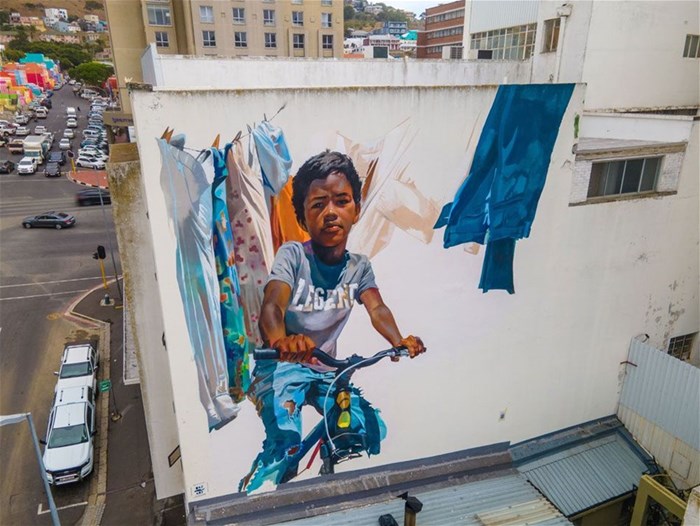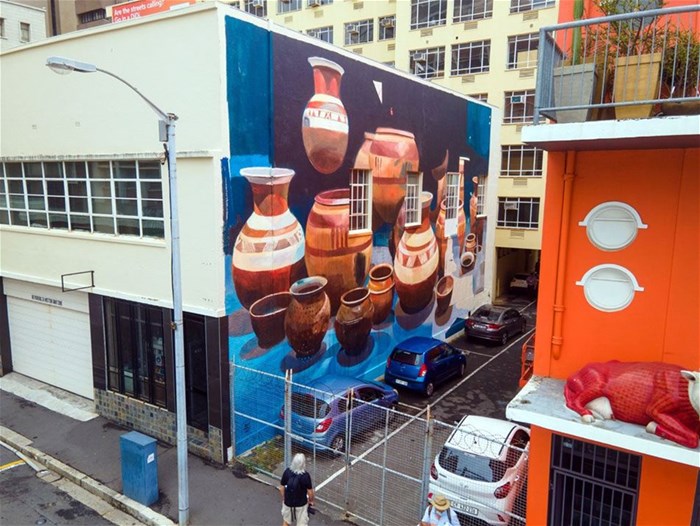Street art, including murals, is a vibrant and integral part of many cities, often reflecting the local culture, history, and social issues, and if you've ever roamed through the streets of Cape Town's CBD, there's no doubt you would have encountered some of these beautiful creations.

Image supplied
This innovative approach, called placemaking, transforms public spaces into vibrant community hubs through the power of art.
“Placemaking is synonymous with safemaking," explains Melissa Cucci, co-founder and creative director at Baz-Art and co-founder of the International Public Art Festival (IPAF), which takes place from 14-18 February 2024 in Cape Town.
"By enlivening neglected areas, we're taking pride in our spaces and making them welcoming for everyone. Placemaking through public art is posited as a beacon of change, potentially marking the beginning of an era where creativity and community collaboration can transform a space and make it more accessible, secure and engaging.”
Annually, IPAF curates a series of public art projects that not only beautify spaces, but also stimulate social interaction, enhance urban safety, economic development, and cultural exchange. This year, the festival begins with activations in The Company’s Garden and unfolds throughout Cape Town's CBD, inviting the public to immerse themselves in a realm where art meets urban living.

Roshana Naidoo, director at Baz-Art. Image supplied
Roshana Naidoo, director at Baz-Art, has been at the forefront of the iThemba Walkway initiative in Gugulethu — a placemaking project that not only stands as a beacon of creativity but also as an emblem of the community's aspirations for a safer, more inclusive environment.
Growing up in a community where street art was almost non-existent, Naidoo personally feels that creativity was not really encouraged. It is only now that she is actively involved in placemaking large-scale murals, brightening and cleaning up neglected spaces for communities to make use of again, and seeing the communities taking pride in their spaces.
"I think the idea of sharing relevant and important information through street art and playfulness is what really sparked my interest [in placemaking]," says Naidoo, who realises that art can be used as a catalyst for change.
Naidoo shares a personal experience where art played a significant role in driving cultural change.
"One standout instance was when I collaborated with a group of individuals who were experiencing homelessness in Cape Town. Together with several organisations, we embarked on a project to establish the city's first mobile wash bus facility.
"Our approach began with thorough research, seeking to understand the unique needs of the homeless population before implementing any solutions. We creatively employed art as a means to engage with them and uncover their specific requirements. I had the privilege of working alongside adults who expressed their thoughts through sketches and paintings, envisioning what access to a shower would mean to them," she says.

Image supplied
"In a memorable and transformative outing, we took these individuals to the Zeitz Museum of Contemporary Art Africa, introducing them to art in all its forms for the very first time. The impact was profound," Naidoo continues.
"The majority of participants described the experience as 'dignified', marking it as one of the most meaningful community projects I have ever been involved in. Through the power of art, we were able to provide a group of homeless individuals with the dignity of being able to shower and feel clean.
"Art is a powerful communication tool and we often express ourselves and who we are through various forms of art."
Placemaking also highlights social challenges, as communities are encouraged and supported in speaking about challenges and working towards patterns of change. Art encourages conversation and storytelling, allowing us to openly express our views, and by bringing attention to these issues, we can start challenging relevant social issues within communities.
Placemaking through art transforms spaces into vibrant epicentres of cultural connection and community engagement, where every brushstroke enlivens the public realm, fosters social interaction, and celebrates the unique spirit and identity of the locale.
Community and collaboration
Naidoo believes that when using art as a catalyst for change, collaboration is important, so much so that the theme for this year's edition is ‘CoAct/Collab’. The theme ‘CoAct/Collab’ is about bringing experts together from different fields of art and creating bigger impacts.
"Within communities, I have seen collaboration through art creating thought-provoking conversations – from community leaders, to local organisations as well as the very locals of that community itself. And this has been the inspiration behind our theme this year. By coming together and working towards a common goal, we see the power of each individual bringing their best to the table, and together we experience ripple effects of success in social change, behaviour, and community pride," says Naidoo.
An example of one such collaboration is the Ithemba Walkway project in Gugulethu, where various experts and community members each with their own strengths and abilities, collaborate on the development and implementation of placemaking, to revitalise and activate unsafe spaces, and create impactful changes and make spaces safe and accessible to the community it serves.
What they bring to the table with their knowledge, resources and unwavering commitment to the well-being of communities in underserviced spaces, is so significant to the success of placemaking.
Transforming spaces and communities
When asked about the future of using art as a catalyst for change, Naidoo responds, saying, "I see a promising future for the use of art as a catalyst for change, especially in South Africa. In this future, we can anticipate significant developments in the regulation and support of the creative economy and art sector, providing numerous opportunities for creative individuals to transform spaces into vibrant and thriving communities."
Art, in this context, serves as a powerful tool for reshaping perceptions and fostering hope and pride in communities that have often lacked these vital elements. By activating and beautifying spaces, we can enable people to take pride in their surroundings and showcase what makes them unique and therefore feel proud of their heritage/culture. It's a means to transcend circumstances and celebrate the essence of a place.

Image supplied
Marina Capdevila, an internationally acclaimed Spanish artist who will be taking part in IPAF 2024, says that through her art, she not only seeks to reflect on life’s depth but also to illuminate and secure the spaces we share.
Capdevila is known for her playful portraits of the elderly in candid nostalgic moments that brighten streets and ignites conversation.
“In bringing the wisdom and warmth of our elders into public view, we cast a light that deters the shadows of uncertainty and fear. The vibrant exaggerations in my works are more than artistic expressions; they are the guardians of our communal areas, inviting viewers to engage not just with the art but with each other in a safer, more connected environment. At IPAF 2024, my aim is to demonstrate how art can transform public spaces into creative havens, where negative stereotypes are dismantled, and every generation can walk with a sense of belonging,” says Capdevila.

Image supplied
To further realise this vision, it is essential that the government and public sector increase their investment in the art and creative economy. This support will not only fuel the growth of the industry but also contribute to showcasing tourism, culture, and heritage, while simultaneously beautifying cities such as Cape Town, Johannesburg and Durban.
Says Naidoo, "The potential for job creation in the arts and creative industries in Africa is immense. As the art sector expands and gains recognition, it generates employment opportunities for countless talented individuals already residing on the continent. This not only stimulates economic growth but also empowers the youth with meaningful employment prospects, allowing them to channel their creativity and passion into sustainable careers."
Looking ahead
In this transformative journey, partnerships between experts, artists, and sponsors will play a pivotal role. Collaborations like these, can serve as a catalyst for change and elevate the role of art in shaping the future of African communities.
"The future of using art as a catalyst for change in South Africa holds the potential to revolutionise the creative economy, create jobs for local talents, and showcase the rich cultural heritage of the continent. With increased government and public sector support, as well as collaborative efforts, we can look forward to a brighter, more vibrant future where art truly thrives," notes Naidoo.
On a word of advice for emerging artists wanting to make positive change, Naidoo says, "It always starts with you. Reach out to others in your endeavours and you will see that a positive wave will happen when you put the first foot forward. It is then through constant commitment, dedication and the ability to show up when you need to, that will set a positive example to those around you. Find out what the social challenges are, and use your creativity to bring people together, and sustain your impact through nurturing your work."

Image supplied
Looking ahead, IPAF continues to contribute to the placemaking movement, working hand in hand with the City of Cape Town in steering the city towards a future where public art plays a critical role in urban safety. "Our goal is to ensure that each project not only tells a story but also contributes to the well-being of its audience," Cucci states.
This is the essence of IPAF's mission: to create art that resonates with the soul of the city and safeguards its heart.
Discover the vibrant streets of Cape Town with a guided tour of the International Public Arts Festival (IPAF), from 14-18 February 2024 at The Company’s Garden. Book your tour at via Quicket and witness the power of collaborative art with a diverse lineup of local and international artists!








































